

The Belgorod region has unexpectedly transformed into an active war zone, causing distress among many Russians. The town of Shebekino is frequently targeted with artillery fire, resulting in severe damage to entire buildings. Despite the destruction, the residents remain in the area, constantly seeking shelter from the shelling. Public transportation has ceased to function, communication is sporadic, and people are forced to hide wherever they can to protect themselves. The local Federal Security Service (FSB) is making efforts to identify the perpetrators but expresses frustration over the lack of assistance from the central government. Meanwhile, Ukrainian sabotage and reconnaissance groups are believed to be orchestrating activities in the Russian border villages, further exacerbating the situation. The state media's deliberate indifference has even sparked outrage among previously loyal residents. A journalist from The Insider undertook a perilous journey to Shebekino amidst the ongoing gunfire and briefly found herself in the custody of security forces who initially mistook her for an AFU (Armed Forces of Ukraine) spotter.
Content
“Anyone taking pictures here is potentially an AFU spotter”
“Our Russian Donetsk or Mariupol”
“Hostages of Shebekino”
“Not a border, but an open door”
“Girls, let's not bring up the subject of conscripts”
“We've been confined to the basement for three days, it seems like Donetsk is more important to the country”
Entering a shelter is impossible without a gas mask
“Evacuated from Shebekino to Shebekino.” Relocation
“Anyone taking pictures here is potentially an AFU spotter”
“We are well aware of the attitude emanating from Moscow towards us. They treat us as if we are a mere village. They can't even bother to correctly pronounce the name of our town, misspelling it with a 'Shch'!” says a man, likely an FSB officer, expressing his indignation in the border town of Shebekino. “We are getting the shit kicked out of us, and yet the news barely reports what's going on here!”
We are sitting in the basement of the Shebekino police station. This is where they brought me after I tried to capture a photograph of a shattered window in a beauty salon located on the main street. Although the shell landed at the House of Culture, the force of the explosion shattered windows in buildings several meters away. Suddenly, military personnel appeared on the scene. 'Anyone taking pictures here is potentially an AFU spotter,' the servicemen said as they confiscated my phone and passport, put me in a vehicle, drove me to the police station and led me to the basement. It's uncertain whether it was intended as an act of intimidation or as a means of seeking shelter from the ongoing shelling. That day alone, Shebekino endured four shelling incidents, and the incessant rumbling from above seemed unending.
Following the impact of yet another projectile nearby, the basement plunges into darkness as the lights cease to function. Despite the lack of illumination, the interrogation persists. The officers, who never bothered to introduce themselves, begin searching for any potential Ukrainian contacts and closely examine the photos found on my unlocked phone. Their attempts to collect DNA samples and fingerprints are hindered by the damage caused by the shelling, making it difficult to operate the necessary equipment. However, as the conversation progresses, it becomes less formal. The demeanor of the officers softens when they discover evidence within the correspondence confirming the identity of the person before them as a genuine journalist. In this particular situation, they have little interest in me as a journalist.

Morning in Shebekino
“We ain't got time to play those games. We're dealing with a real war here, not journalists. It's you folks in Moscow who have no clue what you're doing,” grumbles a frustrated officer, who never identified himself. Although he attempts to avoid directly criticizing the authorities, he fails miserably. Like many residents of the Belgorod region, the local law enforcers are clearly livid about the Kremlin's indifference towards the dire situation in the border region and the lack of assistance. Irritated, my interlocutor laments that the Belgorod region “doesn't even have martial law imposed”. After almost four hours, they finally release me from the confines of the basement.
Belgorod law enforcers are clearly livid about the Kremlin's indifference towards the dire situation in the border region and the lack of assistance
“Officially, they called it a counter-terrorist operation, but that got scrapped. Now, there ain't no special regime in place. But we continue to operate as if there was,” a policeman attempts to justify the reasons behind my detainment, search, and interrogation.
As we exit the police station, an officer accompanies me to my car, which is parked in one of the alleys outside Shebekino Hospital. “You better write about the challenges we're facing while trying to carry out our duties here. Nobody ever writes about it,” the police officer says in frustration. During my time confined in the basement, the town center has transformed: shattered glass now litters the sidewalks, and billows of black smoke rise into the air from behind the precinct. Remarkably, in just three days, the very police station where I underwent questioning would also become a target of an attack.
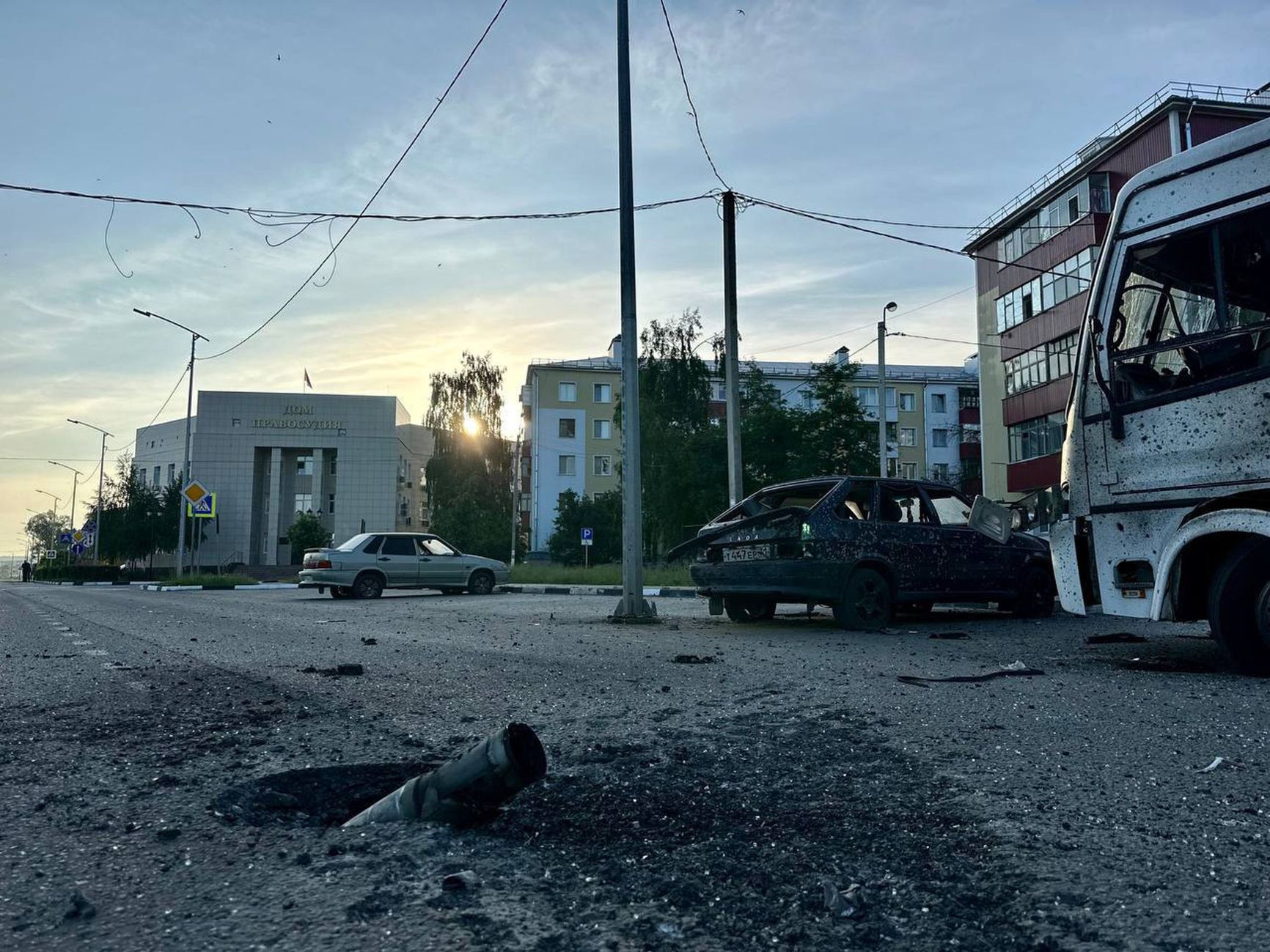
Central Shebekino, the aftermath of shelling
“Our Russian Donetsk or Mariupol”
The impact of Putin's war became evident in Shebekino right from the beginning of the so-called “special operation.” The district had been subjected to regular shelling since February 24, 2022, although it was initially seen as isolated retaliatory attacks. The Belgorod region served as a launching pad for offensives in the Kharkiv and Sumy directions, and Russian military equipment was frequently positioned in fields, “tree plantations,” and near settlements, including the artillery systems used to shell Ukrainian territory. The dramatic escalation took Shebekino by surprise. As recently as May 25 and 26, the town remained relatively calm, with only sporadic sounds echoing through the sky. The locals attributed them to an “air defense operation” and paid little attention. Children continued to play on the streets, and elderly residents leisurely occupied their benches. However, on the morning of May 27, the town was jolted by the blaring siren. Though barely audible in the town center, the explosions directly overhead could not be ignored. Shebekino endured four rounds of shelling that day, with the intensity of the attacks escalating each passing day.
The Belgorod region served as a launching pad for the Russian army's offensive
While driving along Lenin Street, the shelling recommences, prompting us to park the car and quickly seek shelter. Following the arrows indicating the “shelter,” we make our way into a nearby yard, only to discover that the basement door is locked. We wait anxiously for several minutes, hoping that someone with the keys would arrive to open the shelter. In the meantime, I notice a group of women holding onto the entrance door, realizing it's the sole refuge available from the shelling in this courtyard. The women wave us over, and we swiftly join them inside. Suddenly, an explosion resonates above us, causing everyone to scream in fear.
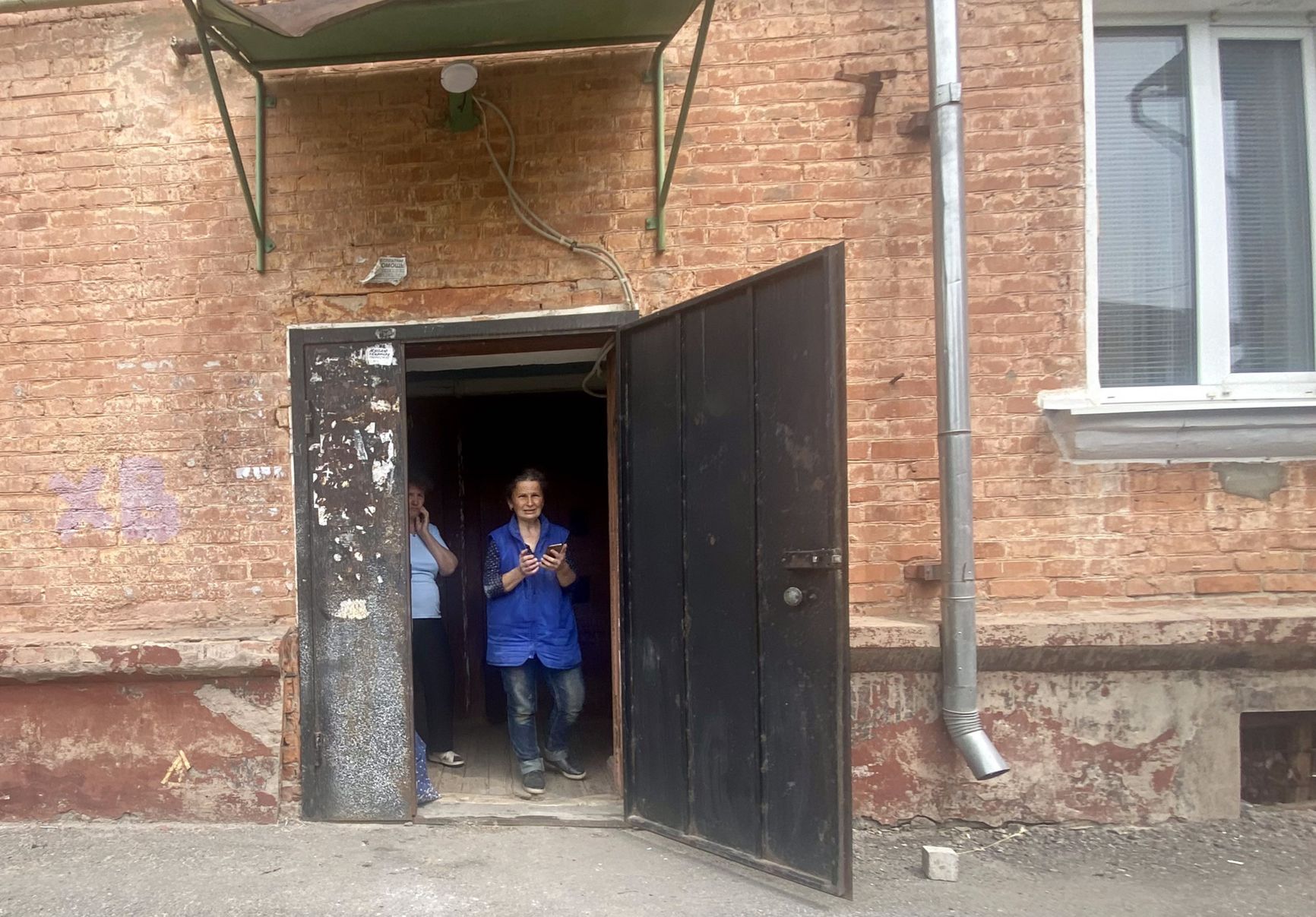
Residents take shelter in an entranceway in Shebekino
“Who could it be? Our own forces or the enemy's?” a woman inquires, peering out from the porch. Many elderly residents in the Belgorod region communicate in surzhik, a blend of Russian and Ukrainian languages. “If there's a whistling sound, it's likely Ukrainians. But if it's just a loud ka-boom, then it's our own forces striking from the region. When you hear that whistling sound, it's more dangerous, a potential direct hit.”
According to local residents, “our own forces” have been positioning military equipment in the vicinity of Shebekino. Judging by the sounds, these forces operate just a few kilometers away. In the previous summer, military vehicles were even present within the town itself. Ural and KamAZ trucks were stationed directly on the premises of Shebekino Hospital, transforming it into what resembled a sizable military base. Servicemen armed with assault rifles guarded the entrances to the facility, allowing access only to those with proper IDs. However, the hospital now stands vacant. Following the onset of intensified shelling, patients were evacuated to Belgorod, with only a handful of medics left behind.
Another resident hurriedly approaches our entrance. She says that earlier in the morning, while she was in her vegetable garden, she had grown somewhat accustomed to the frequent “bangs” in the sky. However, after the noise intensified and became deeply unsettling she urged her son to come and pick her up from Shebekino. “It's all a matter of chance here, after all. It's simply luck,” the woman reasoned. “Of course, things were much calmer before. We never anticipated anything like this happening.”
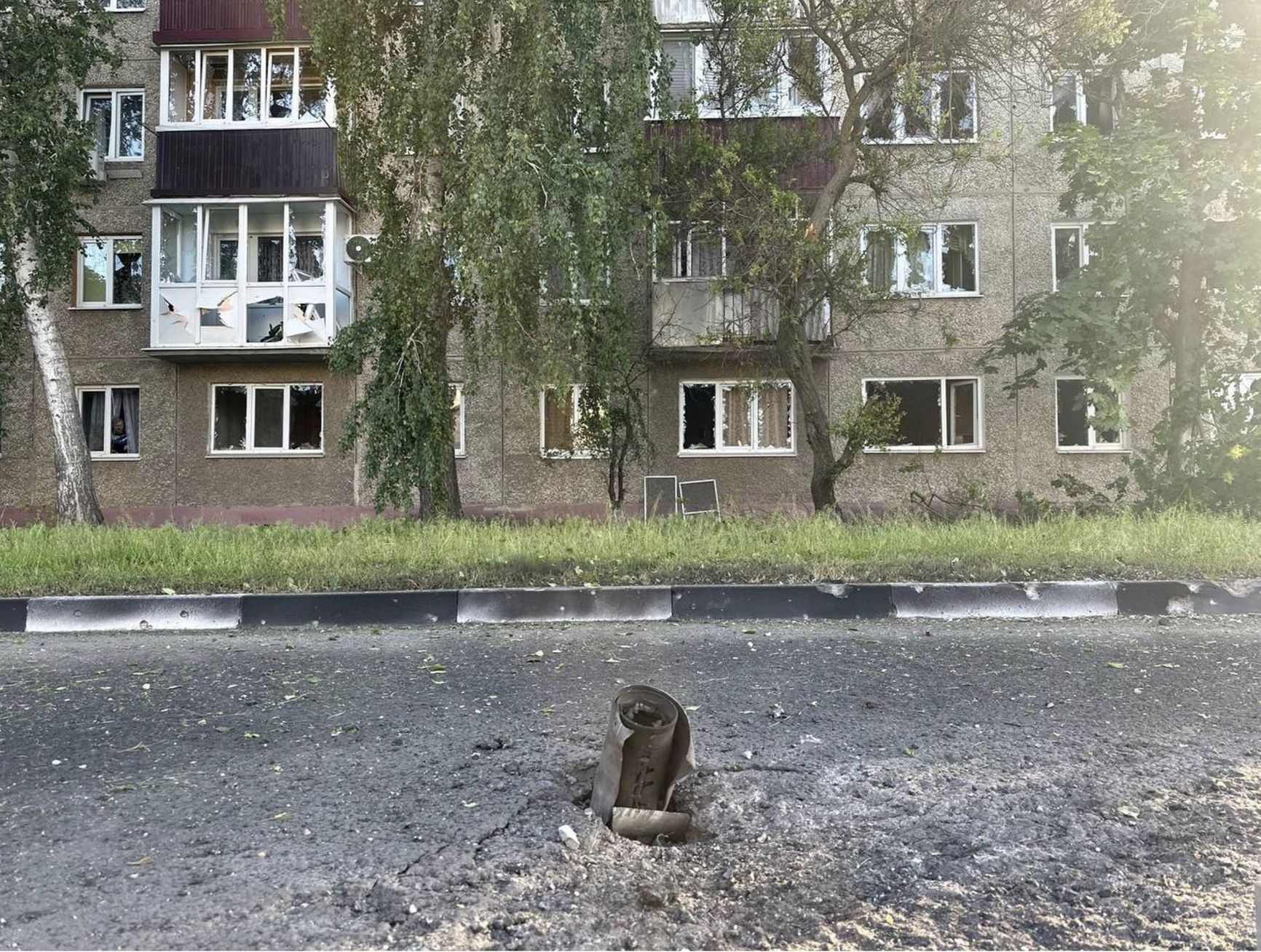
Governor Gladkov's report on May 28 indicated that the Shebekino district had been hit by 116 shells. However, by May 30, the number had risen to 215, and on June 1, a staggering record of 850 shells were reported. On June 2, another 371 shells were recorded. Both Shebekino itself and the border villages of Novaya Tavolzhanka and Murom bear the brunt of these attacks. During the previous summer, a large repair and maintenance station for military equipment was established by the Russian military between the villages of Murom and Arkhangelsk. This location was notable for the presence of multiple launch rocket systems (MLRS) and other combat vehicles during the occupation of the Kharkiv region.
Towards the end of May, seeking shelter in stores within the town was still a viable option. Nearly all buildings with large glass windows were fortified with sandbags to protect against shattering caused by shells or blast waves, minimizing the risk of injuries. Moreover, many retail establishments had ceased locking their basements in anticipation of further shelling. However, after a few days, the situation changed, and the stores closed their doors.
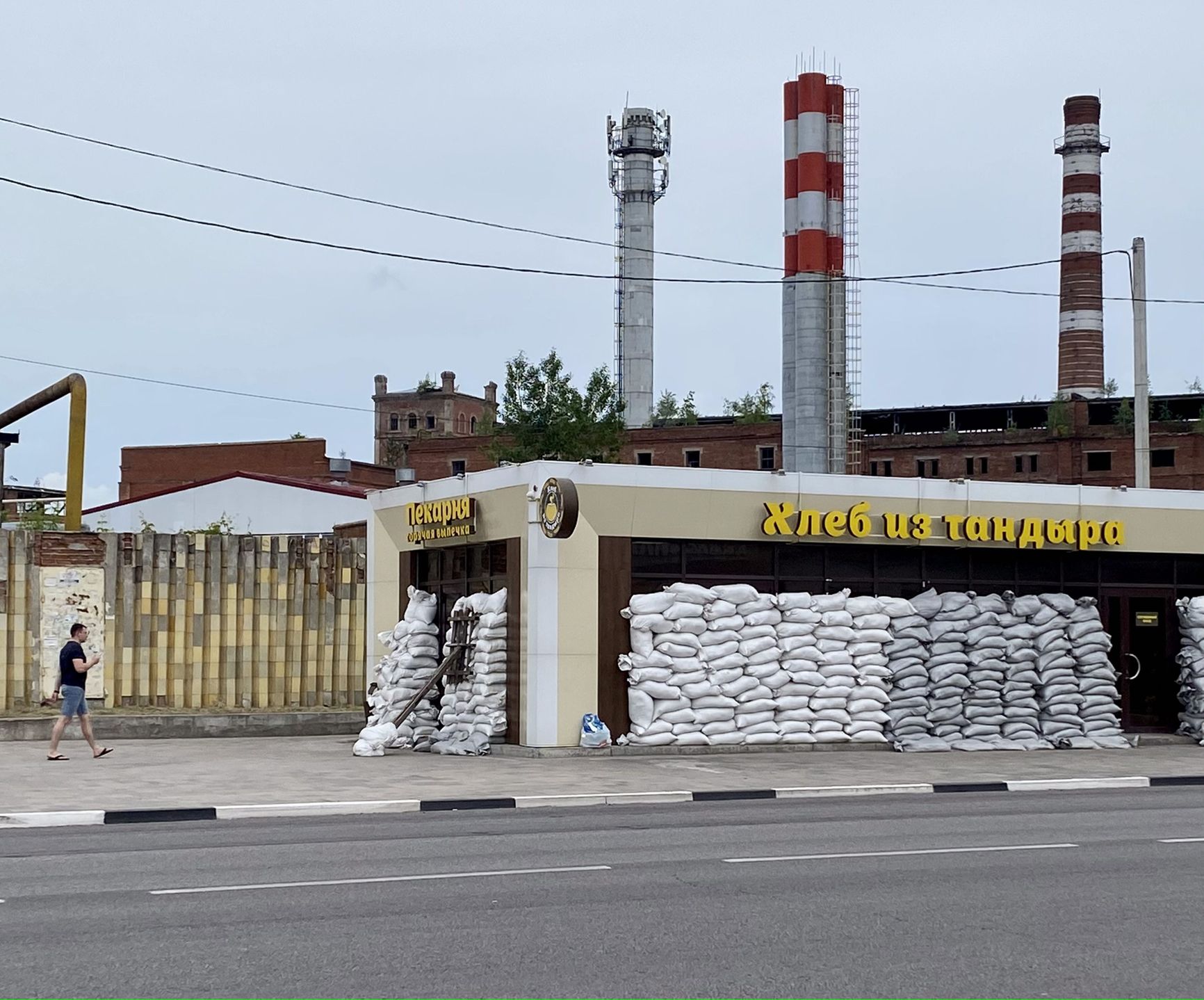
Attempts to save a building in Shebekino with sandbags
Shebekino now has empty streets, with homes in ruins and roofs engulfed in flames. The damages extend to apartment buildings, private houses, administrative structures, a dormitory, two businesses, and numerous vehicles. The town has endured several days without electricity or water, while public transportation and cell phone service remain unavailable. Long queues formed at gas stations on June 1 and 2, as access to the town has been sealed off from all directions, heavily guarded by entire military brigades. Until June 1, it was still possible to reach Shebekino through the village of Titovka, but even that route has now been blocked.
“The whole town is empty, everything's ablaze, smoke rising up everywhere, and these hungry mutts, probably left behind by folks, scrounging around for food. It's a terrible sight,” says a resident who managed to leave Shebekino on June 2.
“Our once beautiful and pristine town now resembles a Russian Donetsk or Mariupol, sacrificed for their reckless pursuits,” Vadim, a Shebekino native, mournfully reflects. Having begun his medical career at Novaya Tavolzhanka Hospital, he now finds himself uncertain if he can even reach it anymore. The town faces relentless shelling, and clashes with Ukrainian soldiers have further intensified. “I fear that Tavolzhanka may cease to exist in the near future,” he says.
“Hostages of Shebekino”
Shebekino was the first Russian town whose residents began to be evacuated because of the war unleashed by Putin, although no official evacuation was announced. But because the town was closed, leaving it became a real quest for many.

On June 1, authorities arranged buses to evacuate the residents of Shebekino to Belgorod. However, the buses were stationed outside the town, requiring people to make their own way there. Some residents had to walk several kilometers on foot to reach the designated location. This meant that the elderly and individuals with limited mobility were left exposed to the ongoing fire for the first twenty-four hours. Due to the town's sealed entrances, their relatives were unable to come and retrieve them. In response, Shebekino residents established self-help chat groups, pleading for assistance in evacuating their parents and pets from the area.
“Take us away from this town, please; we have kids, and mom is sick. What shall we do??? Somebody help!!!?? Please!!!!” a Shebekino resident begs in a chat. There are dozens, if not hundreds of such messages.
“Parents stayed at home, yesterday they were unable to leave, as there is no way to make a phone call. We are not allowed into the town, and they have no way to leave<...>> 😭😭 There is no communication, no way to contact our parents,” Yulia, a chat user, wrote in one of Shebekino chatrooms.
“Yesterday afternoon my aunt had a stroke. But there's no help coming. When I try to call the ambulance, my calls are transferred to the territorial defense or the office of the head of administration. We've signed up for evacuation, but nothing's happening,” Maria writes in a chat. “We've tried everywhere. They tell us to wait. Please help me get my aunt from Shebekino to Belgorod for medical care!”

Queues of departing Belgorod residents at the gas station
According to Vladimir Finogenov, a volunteer from Belgorod involved in the evacuation efforts, they do not always receive permission to enter Shebekino. He says he successfully entered Shebekino twice on June 1, but was unable to do so on the third attempt. Another volunteer, Yulia Nemchinova, says that some people are being prevented from leaving the town by their own relatives.
“There was this jerk who wouldn't let his wife and two kids leave yesterday. We had a chat, explained things in plain language, and finally, they managed to get her out today,” Yulia says. “Today, I gave a ride to a woman who untied her dogs, gave her cats a final pet, said her goodbyes, and left. But there's another woman I couldn't reach. Her relatives took the keys, locked her in the apartment, and left. I have no idea how it came to that.”
An attempt to leave on their own ended in tragedy for two female residents: on June 2 they came under fire and were killed near Maslova Pristan, a village situated between Shebekino and Belgorod. The people in the second car were injured.
An attempt to leave on their own ended in tragedy for two residents of Shebekino: they came under fire and were killed
“The residents of Murom village in the Shebekino district have been left without electricity for eight days, and in neighboring Ziborovka, it's been four days,” report concerned residents on social media. “The authorities seem to be dragging their feet when it comes to organizing evacuations—no clear updates or responses. People who can manage it are taking matters into their own hands and leaving. To make matters worse, there are intermittent communication disruptions in the village.”
In online chats, people are seeking volunteers to provide food for the animals that have been left tied up. However, it's not just dogs and cats that require assistance; some people are also seeking help to feed chickens and goats.
“We are a family of three adults and one 7-year-old child from Maslova Pristan in the Shebekino district. We have a number of farm animals, including 14 goats, 30 chickens, 9 friendly small dogs, and 2 cats. We are urgently searching for new accommodation, preferably a private house, that can accommodate both our family and our animals,” a plea for assistance reads.
However, there are people who move around the region more easily than Belgorod residents themselves, at least in the border villages – these are Ukrainian subversive and reconnaissance groups (DRGs) and fighters of the Russian Volunteer Corps (RDK). Their appearance comes as little surprise to local residents.

Smoke at an exit from Shebekino
“Not a border, but an open door”
“Our border is not just like a sieve, it's wide open! It's like underwear that doesn't cover anything. It's the same situation here,” says Yevgeny from Belgorod, unable to contain his frustration. Sixteen years ago, he came to the region from Norilsk to visit his in-laws, and it felt like the best place on Earth: a spacious house, great climate, and just 60 kilometers away from Kharkiv in Ukraine. They used to visit Ukraine as if it was their second home, finding it affordable and convenient to fly to Europe and Asia. However, now the couple is planning to relocate to Penza out of necessity.
“Our parents and children have already been sent away. I had to take a leave of absence. They left straight from the factory. But I'm afraid to stay, I'd rather lose money than my life,” Yevgeny's wife says.
We find ourselves at an exit of Shebekino near the non-functional Gazprom gas station. It's a rather unplanned detour as we face challenges in navigating the area due to the lack of communication. Our GPS seems to have lost its mind, directing us towards the Ukrainian border instead of guiding us to Belgorod. It's just three kilometers away from here, there's a crossroads nearby and the turn leading to Volchansk, which eventually reaches the “Shebekino” border checkpoint. According to media reports, it was at this very spot on the morning of June 1 that an alleged attempt to breach the border from Ukraine occurred, resulting in a tank battle.
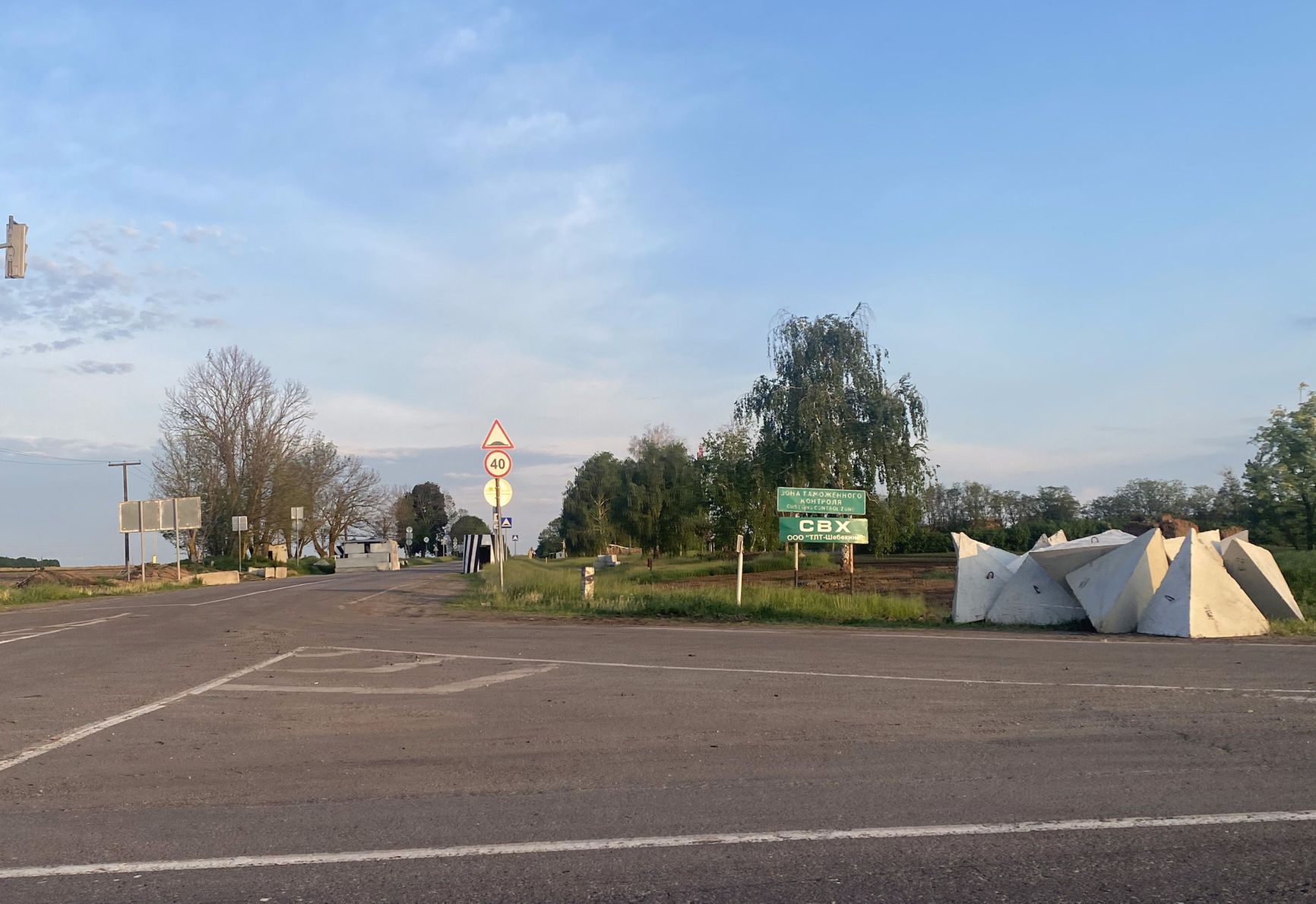
Crossroads and the road to Volchansk, Wagner cones on the right, empty fortifications in the distance
The junction leading to the Shebekino Multilateral Road Border Crossing Point (MAPP) appears deserted. Once a bustling checkpoint, it now stands abandoned. All that remains are vacant bunkers, a raised barrier arm, a weathered sign indicating “customs control,” and a stack of imposing concrete cones known as “Wagner teeth.” These cones were originally used in the construction of the “Wagner Line,” a fortification along the Ukrainian border. Interestingly, as tensions escalated between private military companies (PMCs) like Wagner and the Ministry of Defense, the state media changed the name and started referring to the fortification as the “Belgorod Defense Line.” From this vantage point, one can catch a glimpse of the fortified structure.
The cone fortifications, however, despite their presence, do not seem to deter infiltration into the region. Russian volunteer formations associated with the AFU regularly share photos and videos from Russian border settlements. Although they often do not disclose the exact location, with the help of platforms like Google Maps, one can sometimes identify the areas depicted, especially when aerial footage is involved.

“Defense line” with ditches, trenches and cones
For example, the video captured on June 1 reveals the alleged destruction of military equipment hidden by the Russian military in the village of Novaya Tavolzhanka, specifically on Peschanaya Street. Additionally, the Freedom of Russia Legion shared a photo of a tank bearing a white-blue-white flag, taken at the beginning of Zarechnaya Street in the same village. It's worth noting that the distance from there to the Ukrainian border is approximately 500 meters, and no relocation measures have been implemented in the surrounding settlements frequented by the RDK. Social media posts from Belgorod residents highlight the concerns that the approximately 5,000 inhabitants of Novaya Tavolzhanka are effectively being used as human shields for the Russian military.
Inhabitants of Novaya Tavolzhanka are effectively being used as human shields for the Russian military
Based on the footage shared by the Freedom of Russia Legion, it appears that Russian soldiers are seeking shelter in the homes of local residents. Furthermore, they have positioned BMPs and tanks in close proximity to garden plots and even directly outside residential buildings. Meanwhile, the Russian Volunteer Corps asserts that it is the Russian military who is carrying out shelling on the border villages, purportedly targeting RDK positions.

A tank presumably belonging to the RDK in Novaya Tavolzhanka
Telegram / Freedom of Russia Legion
The guard at the gas station appears unfazed by the attempts to breach the border checkpoints. According to him, Ukrainians frequently enter the region without facing any obstacles and calmly return, while the Russian authorities seem to be slow in fortifying the border.
“They come and go like it's their own backyard. It's like the border is an open door,” the guard complains. “Just the other day, during my early morning shift, I glance into the distance and spot something glinting in the sun about a kilometer away. So, I focus my gaze and what do I see? It's a pickup truck. I turn around and they start firing, either with a machine gun or a grenade launcher, I couldn't tell for sure. They shoot and then just stand there before slowly retreating. They aren't scared of any retaliation because they know it's not gonna happen.”
As we stand there, explosions reverberate from both sides. The few cars passing by are speeding up as much as they can, rushing through the intersection towards Valuiki or Belgorod. “Looks like something's happening,” the guard points towards the field, where white smoke billows into the air. Just then, a text notification arrives on our phone from the Emergency Response and Prevention System; those text alerts warn about shelling or missile threats. In both cases, the message advises taking cover, but this time we decide to move away from the open area, away from the border and the Shebekino multilateral road border crossing point.
“Girls, let's not bring up the subject of conscripts”
The border on the Belgorod region side, facing Ukraine, is guarded by conscripts who often lack proper training. Unfortunately, from time to time, they become casualties of the ongoing conflict. For instance, on June 1, four people, including two conscripts from Yekaterinburg, were reported killed as they came under enemy fire. In January, a conscript from Tyumen also lost his life during shelling. According to the law, conscripts are not supposed to be sent to engage in combat operations but rather to guard the border. Despite the absence of a state of emergency or martial law in the Belgorod region, the reality on the ground depicts it as one of the most intense conflict areas, the lack of official recognition of a war notwithstanding.
The border on the Belgorod region side, facing Ukraine, is guarded by conscripts who often lack proper training
The responsibility of countering the attempts to breach the border near the Shebekino checkpoint and in Graivoron fell upon the conscripts serving as border guards. According to the propaganda channels “Two Majors” and “Veteran's Notes,” approximately 20 border guards and up to 20 conscripts from the Russian Armed Forces were involved in the fighting in Shebekino.
“Once again, we see conscripts and border guards engaged in battle! I demand that our young men be removed from the combat zone! This is a real war, after all!” Messages like these flood the social media accounts of the governor of the Belgorod region. However, there has been no response thus far. On the contrary, Nina Ostanina, a deputy of the Duma from the Communist Party and the chairperson of the Committee on Family, Women, and Children, has made an appeal to send conscripts to guard the border. Essentially, she is suggesting sending them to an active combat zone.

A message of Belgorod volunteers posted to a chat for helping hospitals and the Russian military
The issue of conscripts participating in the war with Ukraine is considered a taboo subject on Russian Telegram channels. It is strictly prohibited to discuss it in local volunteer chats that support the Russian military. Only contributions for assistance are permitted, while conversations questioning the legitimacy of sending conscripts to war are actively suppressed.
“Girls, let's not bring up the subject of conscripts,” a chat administrator writes. “We've had extensive discussions on this topic before, and now we need to focus on the tasks at hand. We all have important work to do.”
In regional chats dedicated to supporting conscripts, their specific needs are addressed. Similar to other members of the Russian military, they lack essential items such as hygiene products, tools, generators, equipment, binoculars, thermal imaging cameras, scopes, and drones.
“Our conscripts urgently require T-shirts in various colors and footwear. They have been without a change of clothes, so it's crucial to provide them with at least one set of clean clothes. Additionally, some of them are in need of proper footwear, as they are currently wearing worn-out boots,” Elena, one of the chat users, writes in the chatroom.
“We've been confined to the basement for three days, it seems like Donetsk is more important to the country”
Belgorod residents were further disheartened by the lack of coverage in state media regarding the situation in their own region. While the people of Shebekino were enduring shelling and seeking shelter, the federal channels were extensively reporting on the supposed victories of the Russian army near Avdiivka, located in the Donetsk region of Ukraine.
While the people of Shebekino were enduring shelling and seeking shelter, the federal channels were extensively reporting on the supposed victories of the Russian army
Tatiana from Shebekino expresses her frustration on social media, stating, “Nobody cares about us. We've been confined to the basement for three days, and my child is terrified and unable to see what's happening outside. Unfortunately, it seems like Donetsk is more important for the country than our well-being.”
Konstantin Selivanov writes angrily, “They've been shelling us since morning, everything is engulfed in flames. And the major TV channels act as if they don't even acknowledge the existence of Shebekino.”
Channel One allocated a mere minute to report on the multiple artillery strikes on May 27. As users expressed their concerns on the channel's social media platforms, demanding more coverage of the situation, the admins seemingly responded by adding the word “Shebekino” to their list of blocked swear words. Comments mentioning the town were swiftly removed. In response, resourceful users started writing “Shebekino” using the Latin alphabet to bypass the filter, but eventually, comments were disabled entirely.
In an effort to draw attention from the federal media, social media in Belgorod initiated flash mobs under the hashtags #shebekinoetorossiya and #zashebekino. Residents shared posts and messages with pleas for assistance, using phrases like “They've devastated half the town. Nobody is coming to our aid. Russians, please help us,” a resident wrote in desperation, requesting that her message be widely circulated and forwarded on.
The efforts of Belgorod region residents seemed to have paid off, as federal TV channels began to address the situation in Shebekino and dedicated more airtime to it. However, some residents felt that it would have been better if the channels had remained silent. In the program “Solovyov Live,” Russian deputy Gurulev called for “smothering and hammering [the enemy]… including Shebekino… including with glider bombs,” apparently considering it a Ukrainian town. On the political talk show “60 Minutes” broadcast by the Rossiya-1 channel, Putin's “experts” failed to mention the town's name accurately, referring to it as “Shmyakino” or “Shimekino.”
Russian deputy Gurulyov called for “smothering and hammering, including Shebekino... including with glider bombs”
Town residents didn't hold back in expressing their thoughts on social media, using strong language to voice their discontent with the speakers.
The dismissive behavior of the state media has not only angered residents, even the loyal ones, but also left them with a sense of being abandoned and ridiculed, as if they are mere pawns being used as a human shield. The impact of this attitude on the approval ratings of the authorities in the region remains to be seen, but it is highly unlikely that these ratings will see an increase.
The dismissive behavior of the state media has angered even loyal residents
“It was amusing to see how, after the mobilization was announced, there were cars on the streets with ripped-off Z-stickers,” says Kristina <name changed - The Insider>, a journalist from a Belgorod newspaper. She believes that the mobilization has had an impact on the mood of the local residents. Over the past year, Belgorod, where we met Kristina, appears to have undergone noticeable changes. In various volunteer chat rooms, administrators have expressed concerns about declining donations. The once prevalent hurrah-patriotic billboards advocating support “For Putin” and “For Russia” have been replaced by posters encouraging people to join the contract service. The presence of Z's on store doors, on windows of buildings in the town center, and throughout the town has significantly diminished compared to a year ago when they were prominently displayed on every corner. Now, “shelter” signs can be seen on every house.
Entering a shelter is impossible without a gas mask
The shelling of Shebekino has prompted concerns regarding the availability of shelters in Belgorod. At first glance, the number of signs would suggest that the authorities treated the matter seriously. However, it became apparent that these signs were merely drawings on the walls, raising doubts about the actual existence of functional shelters. I look for a shelter within the apartment block where I rent. The block is located on Narodny Boulevard in central Belgorod. Last year, this area was shelled, resulting in the loss of five lives, destruction of approximately 40 private houses, and damage to several apartment buildings. Despite the severity of the situation, my landlord is unaware of how to access the shelter or who possesses the keys to the basement.

Signs in Belgorod
Nor were the neighbors aware of it: some advised to take shelter in the bathroom, and others to run “along with everyone else.”
“You won't even have time to get to any shelter if they start shooting,” a neighbor in the courtyard says. “If there's an alarm, you have to call someone on the intercom next door, they'll come out and use their key to open the basement. Several people in our house have keys.”
“Let me be honest with you, sweetheart,” chimes in the second neighbor. “Down in that basement, it's a total mess, absolutely unhygienic! You are more likely to die from staying there than from being hit by a missile!”
After the shelling of Shebekino, the situation with shelters in Belgorod has not changed, a local journalist notes. The arrows on the houses do lead to a locked basement.

A “shelter” on Narodny Boulevard in Belgorod
The “shelter” appears to have remained unlocked for quite some time. The door is barely a meter and a half tall and is also obstructed by dirt and stones from below. A horrific stench emanates from the sealed basement.
Thanks to a helpful utilities worker, I manage to gain access to the so-called “shelter.” However, my sense of regret quickly overwhelms me. My neighbor's warning was spot-on: without a gas mask, one can barely last a minute down there, just as long as they can hold their breath. The utilities worker, who kindly agreed to accompany me, wisely chose to remain outside. It almost goes without saying that staying in this shelter is physically impossible. The interior is dimly lit, lacking any water supply for an extended stay, devoid of benches, and without proper ventilation.

Interior of the shelter on Narodny Boulevard
I try to find out how things are in the neighboring yard, which is also in central Belgorod.
“I'm clueless about where to go if something happens. We don't have any written instructions or plans. At least our neighbor next door has a basement. There used to be a notice with the contact information for getting the keys, but it's faded now. Well, I guess we'll have to go wherever everyone else runs to,” a local resident says.
On the other hand, I encounter another Belgorod resident who has a much more optimistic outlook. He and his neighbors had struck a deal with the owners of a liquor store located in the basement of their building. According to him, the liquor store is all set and prepared to accommodate residents at any time.
“They've stocked up on water tanks and even got some instant noodles. And the taps are always flowing here. We won't be left high and dry,” the man says with a smile.
“Evacuated from Shebekino to Shebekino.” Relocation
Belgorod became the primary destination for the majority of the evacuated residents from Shebekino. Initially, they were accommodated in temporary accommodation centers (TACs). On the first night, thousands of people slept in close proximity as beds were lined up with minimal personal space. There was a shortage of hygiene products and baby food, which were provided by volunteers. Each person had approximately two square meters of space, as the beds in the TACs were densely arranged.
Later, the Shebekino evacuees were relocated from the temporary TACs to student dormitories at technical colleges and Belgorod State University. However, this necessitated the eviction of some students from the dormitories. According to the students, they were forced to vacate the premises at two in the morning. The students were offered rooms with cockroaches and substandard conditions, and those who voiced complaints were simply advised to find alternative accommodations.
In order to resettle Shebekino evacuees, Belgorod students were evicted from their dormitories at two in the morning
Still, numerous Shebekino residents are hesitant to leave, and their reservations are well-founded. In some cases, people may end up residing in temporary accommodations for a year or even longer, similar to what happened to the residents of Sereda, a village located in the Shebekino District. Along with two other villages, Zhuravlevka and Nekhoteevka, Sereda was among the first settlements to be provided with temporary housing last spring. People from these villages are still residing in the TACs. Due to the ongoing shelling, they are unable to return to their homes, and the authorities have not allocated funds to purchase new housing or even secure rental accommodations for a year.
Additionally, the TACs themselves are not always a safe option. The facility where the residents from Sereda were relocated happened to be near the border and was subjected to shelling. A guard was killed in the attack. This prompted online criticism with comments like “Evacuated from Shebekino to Shebekino.” Only after this incident were the residents finally moved to a relatively safer location. However, the duration of its safety remains uncertain. Indeed, Shebekino residents had previously believed that they would not be exposed to frontline conditions.
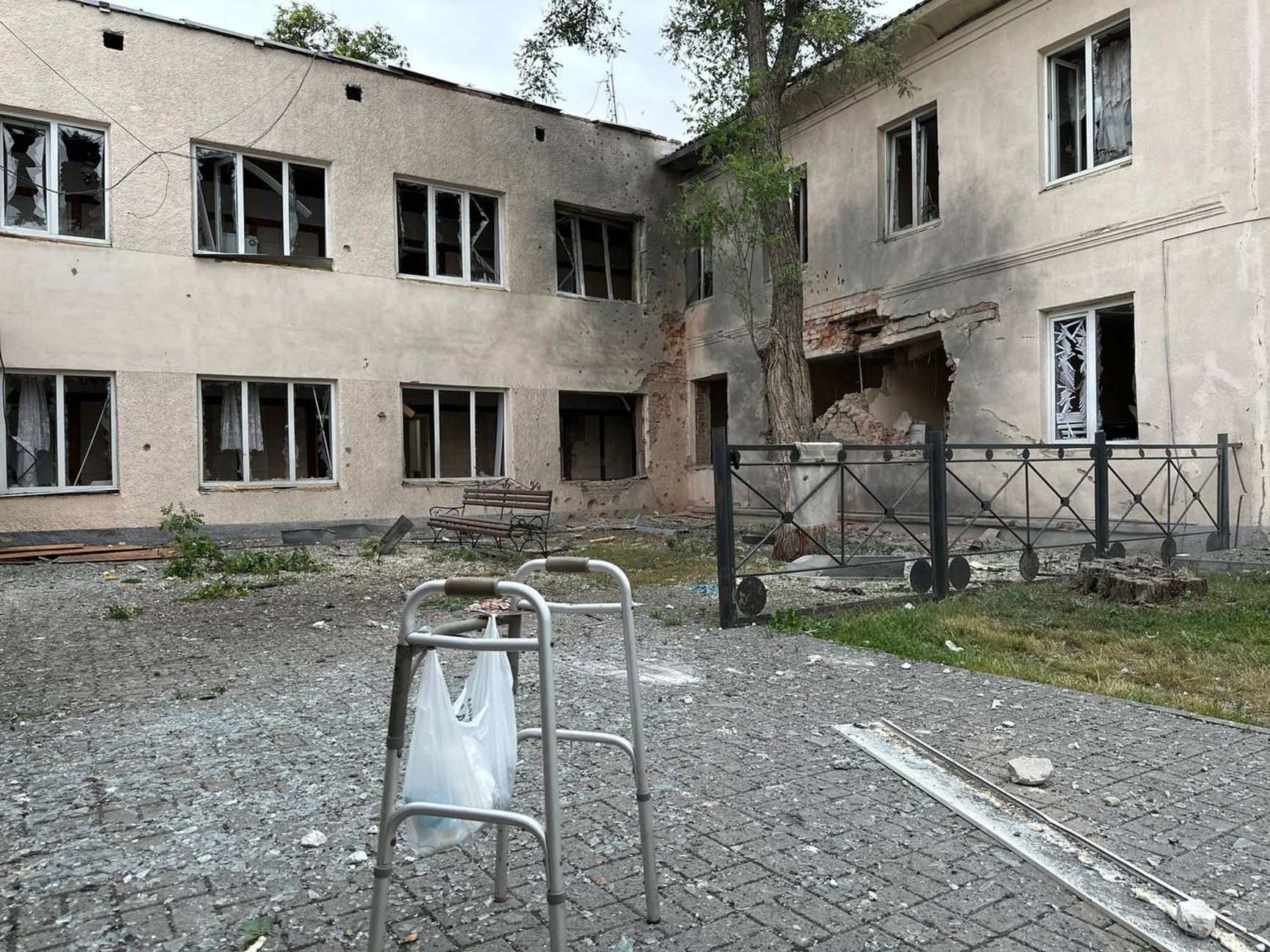
The shelled TAC that housed Sereda residents
The authorities have the potential to alleviate the situation for residents in the region by declaring a state of emergency. This declaration could provide families with multiple children compensation of 15,000 rubles, while others would receive 10,000 rubles for rental expenses. Unfortunately, this solution seems unlikely at the moment. The authorities persist in maintaining the pretense that the border is under control and that there is no ongoing war on Russian territory.